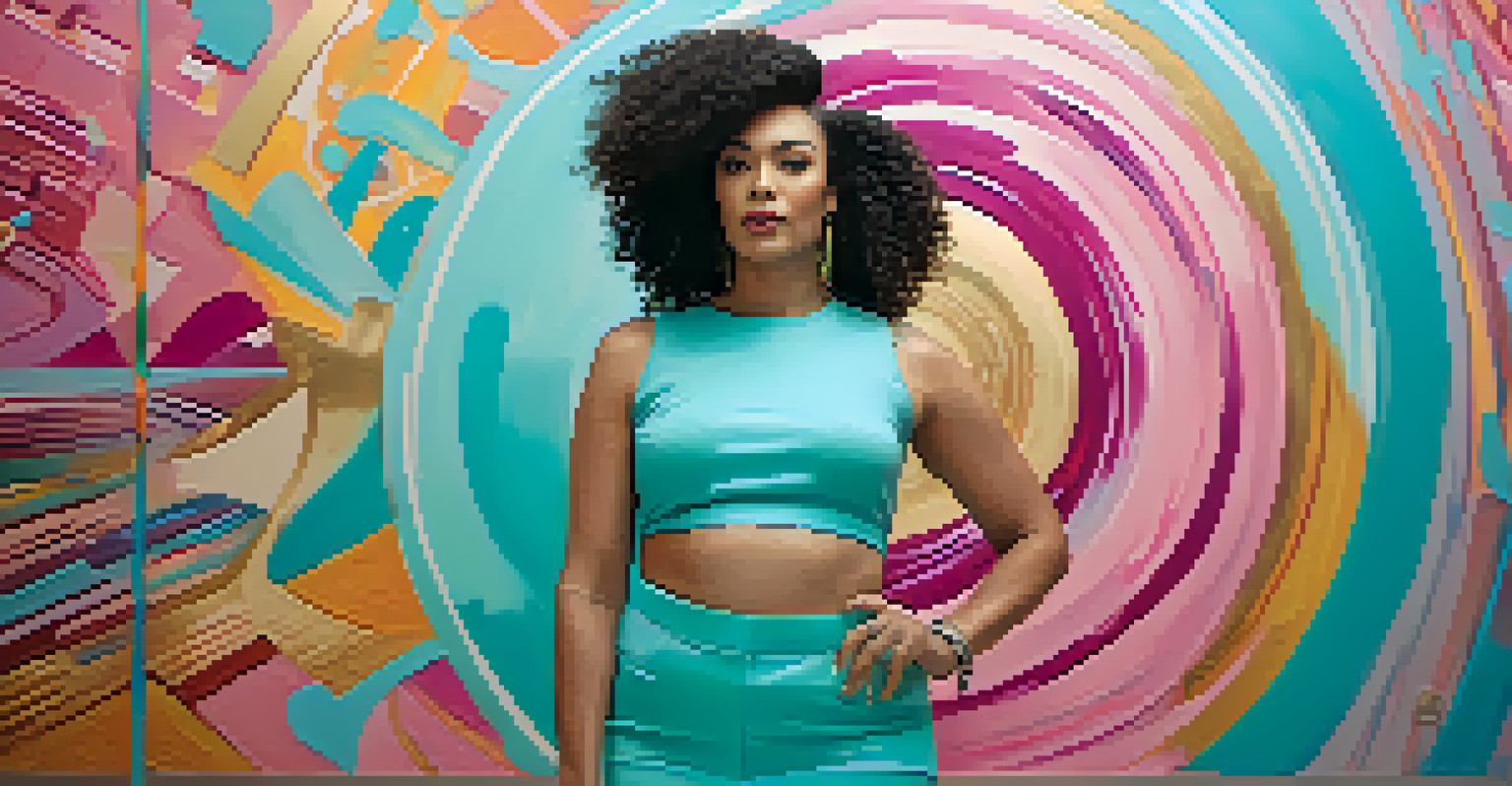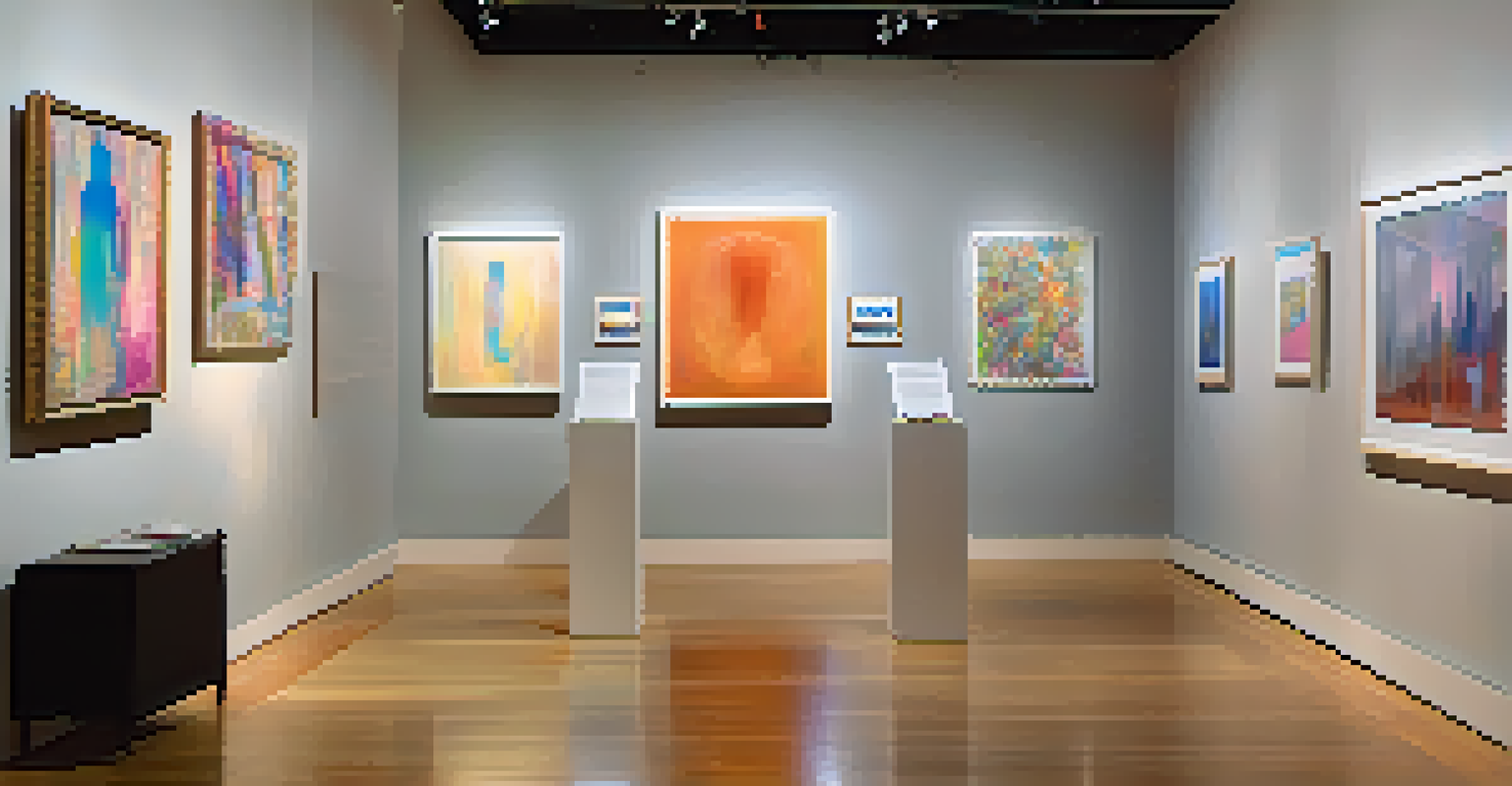Transgender Perspectives in Art: Breaking Conventional Norms

Understanding Transgender Perspectives in Art
Transgender perspectives in art provide a vital lens through which we can explore identity, gender, and societal norms. Artists who identify as transgender often draw from their experiences, creating works that challenge conventional ideas of gender. This unique viewpoint encourages audiences to reflect on their own beliefs and biases regarding identity.
Art has the power to transform and to heal, and it is this power that can help us to understand and accept our differences.
By incorporating elements of their personal journeys, transgender artists can evoke empathy and understanding, paving the way for broader conversations about gender. Their art frequently serves as a medium for storytelling, allowing viewers to engage with experiences they may not be familiar with. This narrative aspect is essential in breaking down misconceptions and fostering inclusivity.
Art becomes a powerful tool for advocacy, with transgender artists using their platforms to highlight issues such as discrimination, representation, and the quest for acceptance. In doing so, they not only reclaim their narratives but also invite others to question the status quo. The impact of these artists extends beyond aesthetics, challenging audiences to reconsider their perceptions of identity.
Historical Context of Transgender Art
To appreciate the role of transgender perspectives in art today, it's important to recognize the historical context. Historically, transgender individuals have often been marginalized, and their stories overlooked in the broader narrative of art history. However, artists like Claude Cahun and Marsha P. Johnson paved the way, using their art as a form of resistance against societal norms.

These early figures not only expressed their identities through art but also sparked movements that advocated for transgender rights and visibility. Their contributions laid the groundwork for contemporary artists who continue to push boundaries and challenge perceptions. Understanding this history helps us appreciate the evolution of transgender representation in the arts.
Art as a Voice for Transgender Identity
Transgender artists use their unique perspectives to challenge societal norms and foster understanding through their work.
Today, the legacy of these pioneers is evident as more transgender artists emerge, each bringing their unique experiences to the forefront. This growing visibility is crucial in redefining art’s relationship with gender and identity. By learning from the past, we can continue to support and amplify transgender voices in the art world.
Impact of Social Media on Art and Identity
Social media has revolutionized how artists, especially those from marginalized communities, share their work and engage with audiences. For transgender artists, platforms like Instagram and TikTok offer a space to showcase their art, experiences, and identities in real-time. This accessibility allows for a more diverse range of voices to be heard, breaking down barriers that once existed.
The role of the artist is to make the revolution irresistible.
Artists can connect directly with their audiences, fostering a sense of community and support that might not be available in traditional art spaces. This interaction not only empowers artists but also educates viewers, creating a dynamic dialogue about gender and identity. Social media serves as both a gallery and a platform for activism, amplifying messages that resonate with many.
Through hashtags and viral trends, transgender artists can share their narratives and challenge stereotypes on a global scale. This visibility is essential in normalizing diverse identities within the art world. Ultimately, social media is a powerful tool that propels the conversation around transgender perspectives forward.
Transgender Art: Themes and Motifs
Transgender artists often explore themes of identity, transformation, and resilience in their work. By delving into personal narratives, they create pieces that resonate deeply with both personal and collective experiences. These themes not only reflect the struggles faced by transgender individuals but also celebrate their triumphs and creativity.
Motifs such as fluidity, metamorphosis, and the body are prevalent in transgender art, representing the complexities of gender identity. Artists may use everyday objects, symbols, or abstract forms to convey their messages, inviting viewers to interpret their work through their own lenses. This openness encourages a broader understanding of gender beyond binary definitions.
Historical Roots of Transgender Art
Recognizing the contributions of early transgender artists helps us appreciate the evolution of representation in the arts.
Additionally, works may address societal expectations and pressures, providing commentary on how these affect individual identities. By tackling these themes, transgender artists challenge viewers to confront their own biases and assumptions. The richness of these motifs adds depth to the art, making it both relatable and thought-provoking.
Challenges Faced by Transgender Artists
Despite the growing visibility of transgender artists, many still face significant challenges in the art world. Issues such as discrimination, lack of representation, and limited access to resources can hinder their ability to create and showcase their work. These barriers often lead to feelings of isolation and frustration among talented artists.
Additionally, the art industry has historically favored certain narratives and aesthetics, leaving little room for diverse voices. This can result in a lack of opportunities for transgender artists to exhibit their work or gain recognition. Overcoming these challenges requires a concerted effort from both the art community and society at large.
Support systems, mentorship programs, and inclusive spaces are essential in helping transgender artists thrive. By advocating for equitable representation and acknowledging the unique perspectives they bring, we can help create a more inclusive art world. Ultimately, addressing these challenges is crucial for fostering a vibrant and diverse artistic landscape.
Celebrating Transgender Artists and Their Contributions
Celebrating transgender artists is vital in recognizing their contributions to the art world and society. Their work not only enriches the artistic landscape but also challenges societal norms and fosters understanding. By showcasing their art, we honor their experiences and the narratives they bring to the forefront.
Art institutions, galleries, and exhibitions are increasingly featuring transgender artists, highlighting their unique perspectives and talents. This visibility is crucial in validating their experiences and inspiring future generations of artists. Celebrating these contributions helps dismantle stereotypes and promotes a more inclusive understanding of art.
Social Media's Role in Visibility
Platforms like Instagram and TikTok empower transgender artists to share their narratives and connect with broader audiences.
Furthermore, acknowledging the work of transgender artists encourages dialogue and reflection within the broader community. By amplifying their voices, we can foster a culture of appreciation and respect for diversity in art. Ultimately, celebrating transgender artists enriches not only the art world but also our collective understanding of identity.
The Future of Transgender Perspectives in Art
The future of transgender perspectives in art looks promising as more artists emerge and societal attitudes evolve. With increased visibility and acceptance, transgender artists are likely to continue breaking conventions and redefining what art can be. This ongoing evolution will further enrich the artistic community and inspire new dialogues.
As conversations around gender and identity become more inclusive, we can expect to see a wider range of artistic expressions and styles. Future generations of artists will likely draw on the experiences of their predecessors while forging their own paths. This blend of history and innovation will create a dynamic artistic landscape.

By supporting and promoting transgender artists, we can help ensure their voices are heard and celebrated. The art world stands to benefit immensely from these diverse perspectives, ultimately leading to a richer understanding of the human experience. Embracing this future means recognizing the importance of all identities in shaping art.